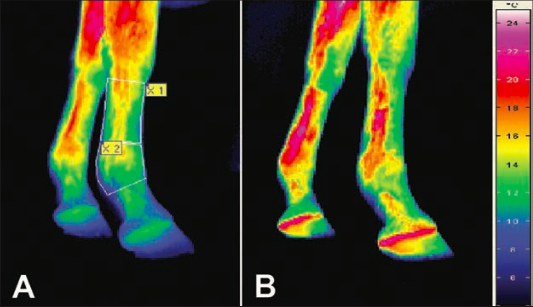
Effect of a bandage or tendon boot on skin temperature
The objective of this study was to compare the skin temperature of the distal limb under a bandage or a tendon boot with that of a bare limb, at rest and after 20 minutes of lunging by use of sensors and thermography.
Ten horses got a closed tendon boot made of neoprene attached and a polypropylene fleece with incorporated ceramic particles bandage that both enclosed the fetlock joint. After recording the temperature at rest, the horses were lunged. Immediately after lunging, the bandage and boot as well as sensors were removed and thermographic imaging was performed. In order to obtain information about the temperature distribution, because the sensors could only determine skin temperature of certain locations.
No significant differences were detected in skin temperature at rest and after exercising of the bare limb. Temperatures increased significantly when a bandage or a tendon boot was used during exercise. After exercising with a bare leg the mean maximum temperature was 14ºC, with a bandage 25ºC and with tendon boot 21ºC.
One of the main mechanisms of thermoregulation is heat loss from the body via convection from the surrounding air. Earlier research looked at the effect of hyperthermia on tendon cell death and found that after heating at 45ºC for 10 minutes’ tendon fibroblast cell survival percentage was 99%. Heating at 48ºC for 10 minutes decreased cell survival to 22%. SDFT core temperatures of 45ºC have been recorded during gallop, with tendon surface temperature reaching 40ºC.
- Modern equine leg protection is marked as ventilated. It would be of interest to compare the effect of different boot brands on distal limb temperature during exercise.
- It is important to remove the leg protection as soon as possible after exercise in order for the tendon temperature to decrease to its natural state.
> From: Westermann et al., AJVR 75 (2014) 375 - 379. All rights reserved to American Veterinary Medical Association. Click here for the online summary.


